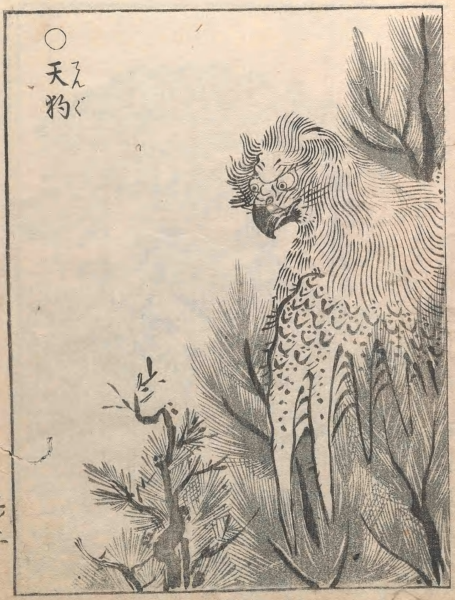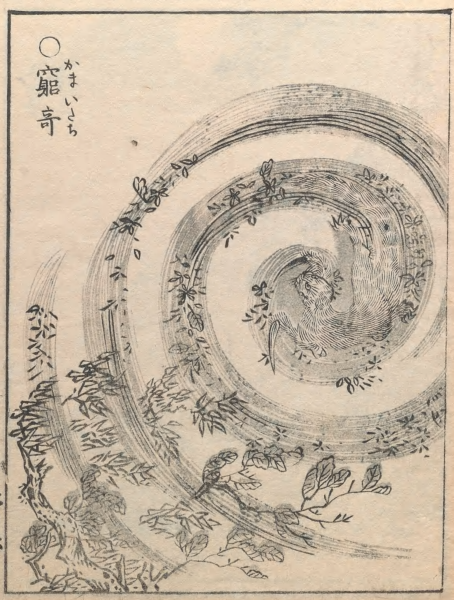The Japan Demonium book of Hiroko Yoda and Matt Alt arrived in the mail this week, and I must say that it is quite an impressive and serious work, nicely produced by Dover of Mineola, New York, the one thing I possibly would have preferred is the plates at some more distance from the spine. As you may expect, I immediately checked the translation of the preface to the Gazu hyakki yagyō 畫圖百鬼夜行 that I discussed recently. Although their phrasing is quite different from that of Joly & Inada, the text is essentially quite similar, mostly that is. Let’s see.

Joly & Inada’s ‘There are extraordinary changes in nature so that a stone may become a sparrow and a fude [brush] may change into a grasshopper’ reads a bit more wittier with Yoda & Alt ‘Let us speak of shape-shifting things, like stone-swallows or inkbrush-crickets,’ certainly as they moreover explain in a note that ‘Certain species of fossil shells with bird-like shapes were called “stone-swallows” in China and Japan. This is also a play on Sekien’s name [石燕, seki 石 is stone and en 燕 is swallow], which is written with the same two characters. Fudetsu-mushi (“inkbrush-bugs”) is an archaic, poetic term for crickets’. NB notes in parentheses are quoted from the original, those in square brackets are mine.
The next lines read, with Joly & Inada ’Toriyama Sekiyen has followed the avocation of a painter for many years and his brush changes also in many ways as he depicts almost everything that is known in nature,’ and with Yoda & Alt ‘The man who created this book, Toriyama Sekien, has enjoyed himself in the field of art for some years. His very brush shape-shifts; in fact there is nothing in all of creation it cannot evoke’.
Then, getting to the work it introduces, Joly & Inada have ‘He published Toriyama Biko 彦 some time ago as everyone knows, now he is going to publish another one after Hiakki Yagio of old pictures, changing and revising (them). It is divided into six volumes numbered In Yo Fu 風 U 雨 Kwai Mei’ – to wich I add that his Toriyama Biko 鳥山彦 of 1773 is also known as Sekien gafu 石燕画譜, as well as a translation of “Hiakki Yagio” 百鬼夜行 as Nightly Parade of a Hundred Ghosts. Joly & Inada add in a note that ‘In Yo Fu U Kwai Mei’ translates as ‘negative, positive, wind, rain, darkness and brightness.’ Yoda & Alt have here ‘He is already famed for his book Toriyamabiko. This time, he took the ancient Hyakki Yagyō scrolls as inspiration, to which he added his own inimitable touch. A publisher took note and prepared blocks for printing a book. Sekien split his work into six volumes: Yin, Yang, Wind, Rain, Darkness, and Light’. They add the following note to the Toriyamabiko: Published in Spring of 1774 [sic], this influential art book’s name has been translated as “Toriyama’s Echoes” but also evokes the name of the yokai “yamabiko.” The Museum of Fine Arts, Boston, has made their copy available online [and I would absolutely advise you to have a look and marvel at that great four-page portrayal of a peacock (inv.no. 2009.3766)]. I would also add that the circumstance that the writer of this preface can cite the mottos for the next three volumes of the Konjaku – Zoku hyakki 今昔 続百鬼 of 1779 as well, suggests that Sekien had by 1775 already completed the first two instalments of his books of ghosts. This is also confirmed later on, as he states that ‘these three volumes of part one, zenpen 前編, are titled Gazu Hyakki yagyō‘.

The preface is concluded, in the Joly & Inada translation ‘These books are entitled Yedzu Hiakki Yagio, he then asked me for a preface, & I could not refuse his request as we have been good friends for many years in poetry meetings, only I hesitated because of the maxim of Confucius (well bred people) dare not talk about Bakemono’ – as concerns the cited maxim, they add the note (Kunshi wa) Kwai Roku Ran Shin (wo katarazu) adding that this comes out of the Rongo [the Analects of Confucius 論語]. This would be (Kunshi wa 君子は people of virtue) Kai Ryoku Ran Shin 怪力亂神 (wo katarazu を語らず).
It is a pity that Yoda & Alt fail to make the association with the Rongo. Their last paragraph reads ‘These are the first three, entitled, naturally, Gazu Hyakki Yagyō (The Illustrated Demon Horde’s Night Parade). By and by he asked me to pen a Foreword. Sekien and I have long been traders of verse, so I could hardly refuse. But if you’re the sort who follows the conventional wisdom of shying away from talks of spirits and demons, you might find yourself wishing to avert your eyes’. Also their ‘traders of verse’ as a translation of 排歌の友にして, or ‘being friends in haikai poems’ is a bit surprising.
As for the writer of the preface, Joly & Inada have ‘Shio Shujin Rosan 紫陽主人老蠶,’ whereas Yoda & Alt have ‘Rōsan, master of Shiyō,’ and even found that this would be ‘A combination of pen names of the poet Maki Tōei (1721-1783), who also wrote under “Rōsan” (Old Silkworm) and “Shiyō-kan” (Hall of Violet Light), among others.’ This is really a great find – which I cannot check with the books I have here at hand–but I do hope that libraries will soon open again. Altogether, I would say that it is interesting to see how the two translations are at times complimentary, so I will continue to work on the Joly & Inada translations of the three other volumes of ghost books by Sekien.
